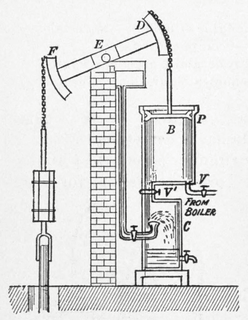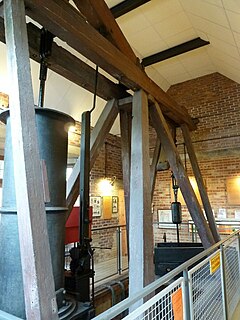
Thomas Newcomen was an English inventor who created the atmospheric engine, the first practical fuel-burning engine in 1712. He was an ironmonger by trade and a Baptist lay preacher by calling.

Thomas Savery was an English inventor and engineer, born at Shilstone, a manor house near Modbury, Devon, England. He invented the first commercially used steam-powered device, a steam pump which is often referred to as an "engine", although it is not technically an engine. Savery's steam pump was a revolutionary method of pumping water, which solved the problem of mine drainage and made widespread public water supply practicable.
A fire engine is a road vehicle that functions as a firefighting apparatus. The primary purposes of a fire engine include transporting firefighters and water to an incident as well as carrying equipment for firefighting operations. Some fire engines have specialized functions, such as wildfire suppression and aircraft rescue and firefighting, and may also carry equipment for technical rescue.

The Los Angeles Fire Department provides emergency medical services, fire cause determination, fire prevention, fire suppression, hazardous materials mitigation, and rescue services to the city of Los Angeles, California, United States. The LAFD is responsible for approximately 4 million people who live in the agency's 471 square miles (1,220 km2) jurisdiction. The Los Angeles Fire Department was founded in 1886 and is one of the largest municipal fire departments in the United States, after the New York City Fire Department and the Chicago Fire Department. The department may be unofficially referred to as the Los Angeles City Fire Department or "LA City Fire" to distinguish it from the Los Angeles County Fire Department which serves the county and whose name may directly confuse people, as the county seat is the city. Another possible reason is that the city and the unincorporated county are often bordering each other and thus the two appear to be serving the same area. The department is currently under the command of chief Ralph Terrazas.

The atmospheric engine was invented by Thomas Newcomen in 1712, and is often referred to simply as a Newcomen engine. The engine was operated by condensing steam drawn into the cylinder, thereby creating a partial vacuum which allowed the atmospheric pressure to push the piston into the cylinder. It was the first practical device to harness steam to produce mechanical work. Newcomen engines were used throughout Britain and Europe, principally to pump water out of mines. Hundreds were constructed throughout the 18th century.

Birdsill Holly Jr. was an American mechanical engineer and inventor of water hydraulics devices. He is known for inventing mechanical devices that improved city water systems and patented an improved fire hydrant that is similar to those used currently for firefighting. Holly was a co-inventor of the Silsby steam fire engine. He founded the Holly Manufacturing Company that developed into the larger Holly Steam Combination Company that distributed heat from a central station and developed commercial district heating for cities in the United States and Canada.

James Rumsey (1743–1792) was an American mechanical engineer chiefly known for exhibiting a boat propelled by machinery in 1787 on the Potomac River at Shepherdstown in present-day West Virginia before a crowd of local notables, including Horatio Gates. A pump driven by steam power ejected a stream of water from the stern of the boat and thereby propelled the boat forward.

A beam engine is a type of steam engine where a pivoted overhead beam is used to apply the force from a vertical piston to a vertical connecting rod. This configuration, with the engine directly driving a pump, was first used by Thomas Newcomen around 1705 to remove water from mines in Cornwall. The efficiency of the engines was improved by engineers including James Watt, who added a separate condenser; Jonathan Hornblower and Arthur Woolf, who compounded the cylinders; and William McNaught, who devised a method of compounding an existing engine. Beam engines were first used to pump water out of mines or into canals but could be used to pump water to supplement the flow for a waterwheel powering a mill.

Gwynnes Limited was a City of London England engineering business, iron founders and pump makers founded in 1849 to capitalise on the centrifugal pump invented by James Gwynne (1804–1850). In 1856 his eldest son, J E A Gwynne, of Essex Street Wharves on the south side of The Strand was awarded a patent for the manufacture of carbon or charcoal powder. Their Strand site became part of the Victoria Embankment built between 1865 and 1867 and Gwynne profited from judicious investment in the reclaimed land. Their Crisp Road, Hammersmith Ironworks and works at Church Wharf, Chiswick, London, were established in 1867 to specialise in the manufacture of these centrifugal pumps and pumping engines This machinery was for use in practically all purposes where large or small quantities of liquid were required to be lifted and dealt with for low or high heads. A limited liability company was formed in May 1897 to own the business.

A wildland fire engine is a fire engine specifically designed to assist in fighting wildfires by transporting firefighters to the scene and providing them with access to the fire, along with water or other equipment. Most commonly used by the United States Forest Service, there are multiple types of wildfire apparatus which are used in different scenarios. According to the National Fire Protection Association, if the apparatus will be used primarily for outdoor and wildland responses, then it is to be considered a wildland fire apparatus and must conform to NFPA 1906.

The history of organized firefighting began in ancient Rome while under the rule of Augustus. Prior to that, Ctesibius, a Greek citizen of Alexandria, developed the first fire pump in the third century BC, which was later improved upon in a design by Hero of Alexandria in the first century BC.

Merryweather & Sons of Clapham, later Greenwich, London, were builders of steam fire engines and steam tram engines.
The Erie Water Works was incorporated in 1865 as the Erie Water and Gas Company to provide drinking water and fire hydrant water for the city of Erie, Pennsylvania. The Water Works, also known as the Erie City Water Authority, replaced the Erie Water Systems. Its board of commissioners operates independently of the city government.

Pyronaut is a specialised form of fireboat known as a fire-float. It was built in 1934 by Charles Hill & Sons Ltd., Albion Dock Bristol, Yard No. 208. Registered number 333833. She is owned by Bristol Museums and based at M Shed in Bristol's Floating Harbour.
Resolution was an early beam engine, installed between 1781–1782 at Coalbrookdale as a water-returning engine to power the blast furnaces and ironworks there. It was one of the last water-returning engines to be constructed, before the rotative beam engine made this type of engine obsolete.

The Newcomen Memorial Engine is a preserved beam engine in Dartmouth, Devon. It was preserved as a memorial to Thomas Newcomen, inventor of the beam engine, who was born in Dartmouth.

A firefighting apparatus describes any vehicle that has been customized for use during firefighting operations. These vehicles are highly customized depending on their needs and the duty they will be performing. These duties can include firefighting and emergency medical services.

Leschi, named for the native American leader Chief Leschi, is a fireboat operated by the Seattle Fire Department. The ship was laid down in 2006 and commissioned in 2007; its sponsor was Sharon Nickels, wife of the then-mayor Greg Nickels.

Paul Rapsey Hodge was an English-American inventor and mechanical engineer. He invented technological improvements used by railroad companies. He also invented a device that ground wheat and other grains into flour that could then be used by bakers, as well as a machine that turned vegetable pulp into paper that could be used by printers. His innovations were useful to many industries. He was a writer of technical manuals in both the United States and England.
John Morris & Sons Limited of Cross Lane, Salford, Manchester, Lancashire, were manufacturers of all kinds of fire fighting equipment from fire engines, manual then motorised, fire retardant foams, and electrical fire alarms, down to firemen's axes and fire buckets.
















